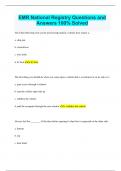Summary
Summary IEB: Visual arts (Dada, Abstract Expressionism, Surrealism)
- Course
- Visual Arts
- Institution
- 12th Grade
These notes offer a clear overview of Dada, Abstract Expressionism, and Surrealism. They cover the origins, key themes, and defining characteristics of each movement, along with analyses of major works and artists. Key figures include Marcel Duchamp and Hannah Höch for Dada, Jackson Pollock and Ma...
[Show more]












